Table of Contents
Folk Regions
Three Ethnic Perspectives
Folk Music of the Florida Parishes
People of the Florida Parishes
In Retrospect

Customs, Traditions, and Folklore of a Rural, Southern Italian-American Community
By Harry P. Becnel, Jr.
Introduction
The years between 1880 and 1920 proved to be an opportune time for the Italian immigrants who arrived at the port of New Orleans. Immediately following the American Civil War, southern Louisiana plantation owners were searching for an alternative labor force to the now free Black man, and they found a productive substitute in the Italian immigrants, most of whom
had worked as farmers in southern Italy and Sicily. Because of poor economic conditions in their homeland, these Italians were eager to seize the opportunity for a better life in America.
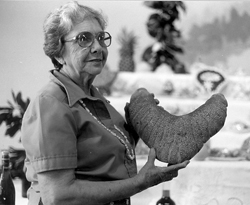
The typical Sicilian immigrant came to New Orleans, found work on south-central Louisiana sugar cane plantations and, after getting settled, sent for his family to join him. Both parents and children worked in the fields. Adults earned twenty-five to thirty cents per day, while children were paid less.
Recognizing the opportunity to purchase land and move up to a higher socioeconomic level, families tended to work hard and live frugally. After years of careful saving, many Italians purchased land in South Louisiana and went into truck farming. They were attracted by the newly developed strawberry industry in Tangipahoa Parish, where land could be purchased for fifteen to twenty dollars an acre. From these beginnings, a sizable colony of Italians settled around Independence, Louisiana, and gradually spread northward toward Amite and southward to the Hammond area.
The families already living in Tangipahoa Parish were of northern European ancestry, and the immigrants from southern Europe appeared to have strange customs and traditions. Accordingly, the Sicilians encountered considerable hostility and prejudice, which strengthened the already close bonds among families.
The following essay is an account, taken from sixteen taped interviews, of the distinctive customs and traditions of the first- and second-generation Italian-American families in Tangipahoa Parish. The interviews were held in the homes of second-generation families. The informants recounted both their childhood recollections and the customs of their immigrant parents. Family photo albums were also brought out, and this interviewer was able to copy many old photographs. Many of the customs and traditions have disappeared as the Italians became assimilated into mainstream American lifestyles. Some, however, have survived, especially if they had social, religious, or economic value for the total community.
Farming Methods
Although some Italian immigrants eventually chose other occupations, most came to the Independence area to farm strawberries. They purchased fifteen to twenty acres of land, cleared it, and planted strawberries in the fall. All the male members of farming families were expected to help with such work, and they plowed with mules and horses. After the strawberries were planted, pine straw was used to mulch them. At harvest time, all the adults and children were involved in picking, packing, loading, and delivering the strawberries to town for marketing. The Independence school system adjusted its schedule to accommodate the community's farming operations. The eventual success of strawberry farming brought in extended family members who in turn bought their own land. Such extended families gave each other the essential social and emotional support which they needed in order to succeed.
Jack Prescia, a second-generation Italian farmer, states that although families made a living from strawberries, they also planted vegetables by night for family use. Prescia says that they would plant root vegetables--such as carrots and potatoes--by the dark of the moon, and leafy vegetables--such as spinach and cabbage--when the moon was full. Some area farmers continue to plant by the moon today.
Household Chores
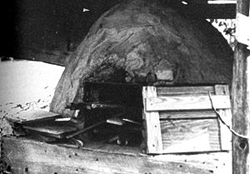
Sex roles for farm and home chores were strictly defined. The men worked primarily in the fields, while women were assigned to household duties. Girls were taught at a young age how to bake, sew, cook, clean house, and care for the children.
As a young girl and later a parent, Laura Noto helped her family from sun up to sun down. She would bake nineteen to twenty-five loaves of bread at a time in an outdoor brick oven, providing enough bread for the week.
To bake bread, a fire with wood (sometimes coal), was started in the oven. After the fire died down, the ashes were raked out, and a small wet mop was used to clean the floor. To determine the correct temperature for baking, a piece of paper was tossed into the oven. If the paper ignited, it was too hot. The chimney at the top was opened or closed to help control temperatures, and a damp rag was used as the chimney cover.
When the paper did not ignite, a flat paddle-like instrument was used to place the loaves of bread in the oven. As many as twenty-five loaves of Italian bread could be baked at a time. Upon removal of the cooked bread, there was still enough heat to bake other foods.
Mrs. Lena Bonfiglio remembers that she learned all the above chores, and also learned to preserve fruit and vegetables and to make salt meat and wine. "We would also make pasta," Mrs. Bonfiglio said. This was done by preparing the dough, rolling it out, cutting it into thin strips, and hanging the strips over a cane pole to dry. To clean clothes, she would boil them in an iron tub outside, scrub them all day with Octagon soap, rinse them, and hang them out to dry. An entire day was set aside to wash clothes. There was no indoor plumbing, so water to wash the clothes was drawn from a well with a hand pump. "Sunday clothes" (dressy items usually worn to church) had to be starched and ironed.
Many women would gather in family and extended family groups to make cookies. Their favorite was the Italian fig cookie. Family reunions were frequent and were often centered around large Italian dinners. Much preparation went into such family meals. A large pot of pasta was prepared with sauce and cheese. Outside in the brick oven, a large supply of Italian bread was baked. When the bread was finished, the remaining heat of the oven was used to bake potatoes.
Childbirth and Midwifery
For the Italian immigrants, as for all turn-of-the-century agricultural families, children were an economic asset. The more children, the more help there was to handle farm and home chores.
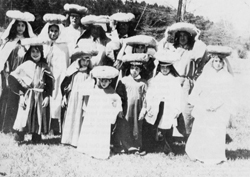
Bonds of friendship between families grew stronger with the birth of children. Godparents were chosen from among close friends or relatives, to help with the religious upbringing of the child and to ensure that the child would not be orphaned if the parent died. Such selections also strengthened the bonds between friends and relatives. The man chosen as godfather was usually the best man at the parents' wedding, or a good friend (Padrino or Compare), and the godmother was chosen in a similar fashion. This custom continues today. In many families, every time a child was born, there would be a christening celebration. Family members and friends were all invited, and relatives would come from as far away as New Orleans.
It was customary in Sicily for a relative or friend to act as a midwife. This custom continued into the first- and second-generation of Italians in the Independence area. While growing up in Sicily, Rosida Anzalone learned midwifery from her mother. It was not unusual for a local citizen to step into her home and say, "Hey! Rosida, it's tima for da party," which meant that someone was going to have a baby, and she was needed as a midwife. The phrase, "tima for da party," was intended to keep the Anzalone children from knowing about an upcoming birth.
Mrs. Anzalone would not accept any payment for her services. When arriving at the home of a woman in labor, she would check the woman and could immediately tell if the baby was in a transverse or breached position. If either of these positions was noted, she would refer the mother-to-be to a professional doctor. Because of her expertise, Mrs. Anzalone was popular among midwives in the Independence area. Even Dr. Newman, the town physician, would call upon her on occasion.
According to Joe Pizzolato, another popular midwife in Independence was a Black woman by the name of "Aunt" Melinda. A third midwife, Antoinette DiVincenti, went to school and received a license in midwifery, but she worked only one year in Independence and then moved to New Orleans. A popular midwife in the Amite area was a Mrs. Mozart.
Courtship and the Marriage Celebration
The Sicilian tradition of marriages arranged by parents tended to continue among the second-generation Italians in Tangipahoa Parish. The children were not allowed to date before marriage. They were not allowed to hold hands or kiss until after the wedding. "I could not even kiss my future husband the day I bought my wedding clothes," Mrs. Bonfiglio said.
When a young man would feel attracted to a young girl in the community, he would ask his father to arrange a marriage. The proposal was then made to the girl's family. The girl's parents would delay their decision until they could conduct an investigation of the young man. For about one to three weeks, the girl's parents would visit with the boy's family and friends before making a decision. This would come after the man's family had investigated to find out if the girl knew how to cook, bake, and sew. The girl's wishes were considered; however, there was much pressure placed on the young woman to marry the parent's choice, especially if the family was very close friends with the parents.
Agatha Guzzardo recalls the arrangement of her own wedding when she was eighteen. Her future husband, Tony Guzzardo, already knew that he wanted to marry her when she was only eleven, but it would be five years before he would try to arrange the marriage. During this time, Agatha worked in a grocery store, and one day she met another young man who came to the store on a white horse. He returned frequently, and her mother figured this man was very fond of Agatha, and was not there to buy merchandise. When Agatha was sixteen, this young man's parents asked if she would marry their son. At the same time, however, the Guzzardos were also busy trying to set up Agatha with Tony. The Guzzardos invited Agatha's family over for a party and had Agatha meet Tony, but she had her heart set on marrying the other man. But due to the close relationship of the two families and her parents' discovery of some negative things about the other man, Agatha was talked into marrying Tony.
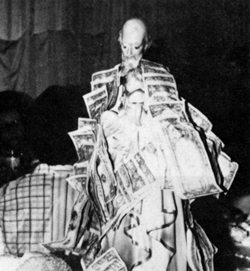
Some of the young women had more to say in the decision-making than others, as is seen in the following story told by Mrs. Noto. She recounted that by the time she was sixteen years old, she had eleven proposals; one even came when she was just eleven years old, and three came from her eventual husband. On occasion it was customary for a man's family to ask the hand of a young girl, who was then promised to the man when she became ready for marriage. Mrs. Noto's father would reply to such inquiries, "My little girl, she is still on a bottle." Mrs. Noto claims that most of the time she refused proposals because she did not believe she was ready to marry until she was sixteen. She knew most of the men in the area because she went to church in Independence. "They would spot me," she said, "and then have their parents find out about me."
After the marriage was arranged, plans were made for a Sunday wedding and reception to follow. The prospective groom would purchase the wedding dress and pay for the wedding. The woman's family bought and made a trousseau and furniture for the new home. The boy's family also paid for the wedding reception, which was much more elaborate than it is today. Some receptions lasted two to three days. Most, however, lasted all day Sunday and through half the night.
The wedding reception usually took place in the home of the groom. His family would slaughter a calf and bake it all night before the wedding. Meat, pasta, potatoes, peanuts, and wine were usually served at the reception. To make room for dancing and music, a partition or wall was sometimes removed in the home and then replaced the day after the wedding. Music was provided by friends and relatives. The mandolin, pistolato, Jew’s harp, accordion, and an occasional harmonica were the main instruments used in Italian music at that time. A large tub of cold root beer was provided for the children, while the parents mostly drank homemade strawberry or raisin wine, commonly known as "raisin jack."
Some second-generation Sicilians believe that the traditional arranged marriage should be revived. For example, Mrs. Josephine Leto believes that today there is too much emphasis on courtship, romance, and love. When she got married, she said, she did not have "love" in her vocabulary. She remembers using the word "like" or "dislike," but not "love." She also feels that it would be good to return to the old system of arranged marriages because the parents are wiser and can be more objective in investigating the prospective marriage partners.
Medicinal Remedies
Many household remedies were brought to this country by the Sicilians in Louisiana. Some of these practices continue today.
Mary Bonfanti recalls several household remedies which were once used for various maladies. "As a child, my mother used to give us castor oil once a month to keep us healthy," she said. "Coal oil or iodine was put on a cut as a first aid remedy. To prevent a mother from having a child with birthmarks, the pregnant woman was immediately given any food she desired. If she did not get the food and then touched herself, the baby would have a birthmark in the same spot she touched. The birthmark on the baby would be in the same shape as the desired food. However, if the desired food was not available, the pregnant mother was instructed not to touch her face or neck." The second-generation Italian women who were interviewed believed in this birthmark phenomenon.
Some local women had an instinctive skill for curing sickness. Mrs. Noto regrets that she was never able to attend school, because she believes she had the potential to become a medical doctor. People would come from miles away with sickness, and she would cure them. "Something would just come into my head about getting some grass, and I would mix it with other stuff, and they would get well," she said. A woman was brought to her who could not walk, and Mrs. Noto fixed some "medicine." In three days, the lady was able to walk. Eventually, Mrs. Noto decided to stop because she realized that the law did not allow her to practice medicine.
Another woman, Rosida Anzalone, helped mothers whose babies kept crying without apparent reason. She would place the baby on her lap, grab the baby's hands and pull them down toward its feet. If the baby did not stop crying, she would hold the child in the air by the hands and feet and then let go of its feet. She said the child would then stop crying.
Mr. Pizzolato says he can remember having malaria in 1917. His family was very concerned when he got sick, and they called Dr. Strange, who recommended that they starve him. As a result, he became so thin and sickly that his mother became even more concerned. One day, his father noticed that Mr. Pizzolato was just skin and bones. At that point his father told his mother that he did not care what the doctor prescribed, he just couldn't see starving the child. They started feeding him and asked for help from an aunt in New Orleans who sometimes treated people. As soon as the aunt arrived, she went into the field, clipped the tender tops off some wild grass and boiled them. She then had Mr. Pizzolato drink three glasses of it and three more glasses each day for nine days. He followed her instructions and recovered within two weeks.
For heat stroke, this popular remedy was used by many families in the area: if a person came in from the field with high fever, a bowl of water was placed on his head. Then a coin was tied into an oil-soaked rag, and this was dropped into the water so that the ends of the rag stuck out of the water. The rag was then lit with a match, and a glass was placed over the flame. The glass was assumed to have sucked out the water and pulled the fever out of the person's head.
A mustard plaster was used by many families to cure a chest cold. It was assumed that by taking a hot pasty mixture of flour, vinegar, and water and spreading it over the chest and letting it dry, the person could rid himself of the cold symptoms.
Music
Singing and dancing were important in nineteenth-century Sicily, and immigrants carried this cultural tradition to the Independence area. In the old country they had learned to play instruments such as the mandolin and accordion, by ear. Tony Anzalone said anyone who could sing could learn to play a musical instrument by ear. "If you can't sing it, you can't play it," he said. This principle was known in Italian as safagio. In some families, such as the Orlandos, every child learned to play musical instruments, and they did so by ear.
A brass band was formed in the 1880s by local family musicians. By the 1920s, under the leadership of Sam Marretta, the band was flourishing. The band sported various uniforms, one of which had a leather pouch attached to the waist for carrying sheet music.
The brass band was a social and recreational entity for the Italian-Americans of Independence. Ninety percent of the band members were of Italian descent. In the early days, the band would play for almost every community occasion, including wedding receptions and feast day celebrations. Feast days such as St. Joseph, St. Expedito, St. John the Baptist, St. Mary, and Our Lady of Perpetual Health were just some occasions when the band would perform.
In the 1920s, the band was paid twenty dollars total, but later they earned five dollars per man. Of course, the feast day sponsors also provided meals. Mr. Pizzolato remembers two groups that were outgrowths of Independence's original brass band--the Peerless Revelers Orchestra and the Sonny Starnes Band. Both of these bands were influenced by the big band era and did not play Italian music, as did the brass outfit. The brass band members would gather every Saturday night at a different member's home to practice. Mrs. Bonfanti recalls that when she was a child, she used to help bake cookies and pies, and served them to band members when they would practice at her home. "All the band members would practice each week at our house," she said. "They would have a great time. This was their recreation."
The brass band, which now has twenty-six members, continues to play for special occasions throughout the year.
Religion and the Saints' Feast Days
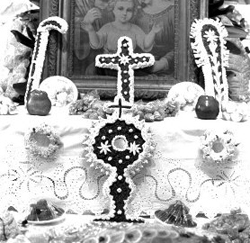
Louisiana's Sicilian immigrants tended to retain their devout Catholicism and fanatical devotion to the saints. Most homes had an altar with a statue of the family's favorite saint; some families went so far as to build a chapel. On the feast day of that particular saint, there would be a celebration with the recitation of the rosary. Bells would ring at certain times of the day at the Mater Dolorosa Church in Independence, and families in the surrounding area would stop for a moment of prayer. Some individuals would sing a prayer for every saint. Although women tended to be more devout than men, Mr. Phillip Sinagra was regarded as one of the area's most religious people. He was a member of the St. Joseph Society, and had a special devotion to the rosary. People could see his lips moving in prayer as he plowed the fields or walked back to his house. On the St. Joseph feast day celebration every March 19, he would attend ten or fifteen St. Joseph altars in town.
The St. Joseph altar is a special way to show devotion to St. Joseph. The altar is planned months in advance by the female friends and relatives of participating families. In this way, they can thank St. Joseph for a favor granted or in anticipation of one. The large altar is adorned with cookies, breads, or vegetables, with Lenten restrictions considered. On the average, twelve disciples are chosen to sit at the altar on the day of the feast. They are fed first. Then the family and friends partake of the food on the altar. Traditionally, the disciples chosen are relatively poor individuals. At one time, as many as thirty or forty St. Joseph altars were built each year in the Independence area. The streets and roads were packed with visitors going to and from these altars. The previously mentioned brass band would travel to each altar, play, eat, and then move on to the next altar.
The local Catholic church and the St. Joseph Society staged an annual procession through the streets of Independence. Nine men carried the statue of St. Joseph. A priest recited the rosary to the people, while the brass band played intermittently between prayers.
A St. Joseph chapel was also located at a family home on Red Hill Road in Independence. At one time, there was a prayer service conducted on St. Joseph's Day. The tradition continues today, but the younger people are not as devoted to carrying it on as were the older folks.
Although the St. Joseph feast day is the primary celebration of a saint throughout the year, there are four other chapels in the area that deserve mentioning for their feast days. The first of these is the St. Expedito Chapel located northeast of Independence on Brickyard Road. Here, there is an all-day celebration which attracts hundreds of people for games, music, food, etc.
The Catholic Church does not recognize St. Expedito as an official saint; however, a large number of families are much devoted to this particular saint. Local folklore states that one of the immigrants received a crate from Sicily which had the word "expedite" written on it. The family opened the crate and found an unmarked statue that appeared to be a saint. The family decided he must be St. Expedito and began praying to him for special favors. Upon receiving the special favors, they built a chapel in his honor. The Book of Saints lists St. Expedito as a seventeenth-century German who is revered as the saint of procrastinators.
Another chapel which has a colorful history is the Mother of Grace Chapel near Tickfaw, La. A local resident, Mrs. Spica, dreamed that Our Lady appeared to her and told her to build this chapel in her honor on her property. Each year since the chapel was built in 1927, hundreds of people have come for the feast day celebration. The statue of the Mother of Grace is carried through the streets of Tickfaw, and when the crowd arrives at Our Lady of Pompeii Church, a mass is held. Joe Fideli claims that immediately after the second chapel was built in 1970, a miracle occurred within the chapel. One of the local residents placed a wreath of fresh roses on the statue's head, and these roses did not wilt or decay, as is normally expected within two weeks. Months went by, and the roses continued to appear fresh. Word spread and hundreds of visitors came to witness what many were calling a miracle. Because too many people were burning candles in her honor (as many as 125 candles were burning at one time in the small 20-foot by 25-foot chapel) and a few people were pulling the roses off the wreath, it was necessary to remove the wreath and place it under glass for storage.
The other two feast days, Our Lady of Perpetual Help and St. John the Baptist, also have chapels in the area and have small celebrations each year in honor of the saints. They are also open to the public throughout the year.
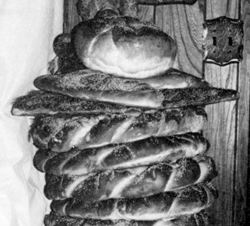
Parish. Photo by Karen Warren, courtesy Center for Regional Studies, SLU.
Today, many Sicilian-Italian customs and traditions remain prevalent among Italian-American families in the Independence area. Other customs, through Americanization and assimilation, have faded or been modified. Those that have survived, especially religious and food customs, have done so because of the social and religious value attached to them. They give the Italian American a sense of community, pride, and identity as a family and ethnic group.
As a means of preserving, expressing, and celebrating Italian customs and traditions, the event known as the Independence Italian Festival occurs yearly during the last weekend in April. Italian music is played, while people enjoy traditional foods. Also, an Italian museum on the grounds affords each person the opportunity to acquire knowledge of earlier lifestyles and folklore. The museum is also open to the public throughout the year on certain days of the week.
Bibliography and Archival Resources
Anzalone, Lena. Independence. Interview by Harry Becnel, Jr., September 29, 1983.
Anzalone, Mary Miceli. Independence. Interview, by Harry Becnel, Jr., September13, 1983.
Anzalone, Sam. Independence. Interview by Harry Becnel, Jr., October 12, 1983.
Bentivegia, Kelley. Tickfaw. Interview by Harry Becnel, Jr., December 10, 1983.
Baiamonte, Joe. Amite. Interview by Harry Becnel, Jr., September 30, 1983.
Baiamonte, John V., Jr. "Immigrants in Rural America: A Study of the Italians of Tangipahoa Parish, Louisiana." Ph.D. dissertation, "Stark: Mississippi State University." 1972.
Bonfanti, Mary Prestigiacomo. Independence. Interview by Harry Becnel, Jr., October 15, 1983.
Costanza, Angelina Anzalone. Independence. Interview by Harry Becnel, Jr., October 12, 1983.
Fideli, Joseph. Tickfaw. Interview by Harry Becnel, Jr., November 28, 1983.
Guzzardo, Agatha Uli. Independence. Interview by Harry Becnel, Jr., March 15, 1984.
Leto, Josephine Potitto. Independence. Interview by Harry Becnel, Jr., March 15, 1984.
Liuzza, Annie DiVincenti. Independence. Interview by Harry Becnel, Jr., September 10, 1983.
Margavio, A. V. and Salomone, Jerome. "The Passage, Settlement and Occupational Characteristics of Louisiana's Italian Immigrants." Sociological Spectrum, Oct/Dec 1981.
Notariano, Salvadore "Sam". Independence. Interview by Harry Becnel, Jr., October 26, 1983.
Noto, Laura Michelli. Independence. Interview by Harry Becnel, Jr., September 18, 1983.
Pandolfo, Rev. Lawrence. Tickfaw. Interview by Harry Becnel, Jr., January 10, 1984.
Pizzolato, Joseph. Independence. Interview by Harry Becnel, Jr., September 13, 1983.
Prescia, Jack. Independence. Interview by Harry Becnel, Jr., September 15, 1983.
Sampere, John and Anthony. Independence. Interview by Harry Becnel, Jr., December 23, 1983.
Savarina, Grace Liuzza. Amite. Interview by Harry Becnel, Jr., September 10, 1983.
Sinagra, Rose Anzalone. Independence. Interview by Harry Becnel, Jr., December 11, 1983.
Tamburello, Rev. Dominick. Independence. Interview by Harry Becnel, Jr., September 17, 1983.


